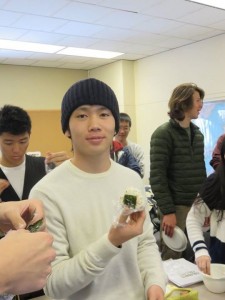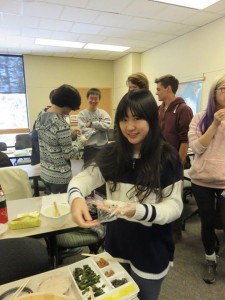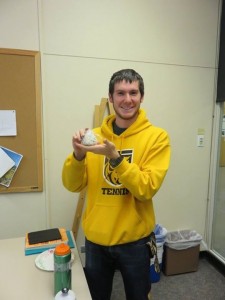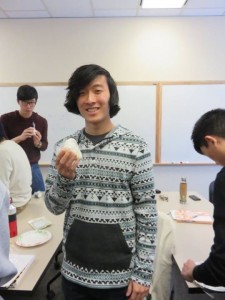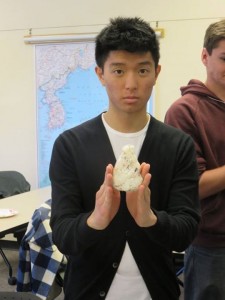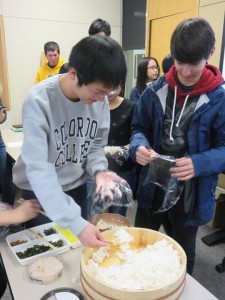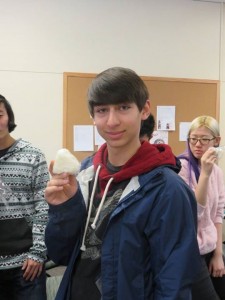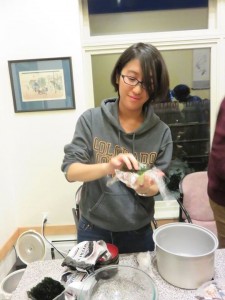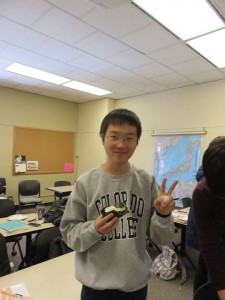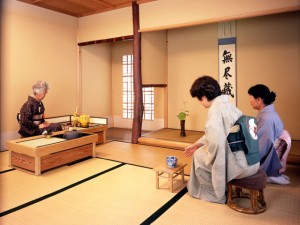Language is both an indispensable aspect of culture and a way to approach culture. This week, we had a special event after class-change the world with onigiri. For Japan, food has always been an essential part of the Japanese traditional culture. It not only satisfies the appetite of the Japanese, but also represents a unique living attitude that immersed in Japanese people’s daily life. The word onigiri is directly translated from the sound of the word「おにぎり」in Japanese. While the particle お often refers to a respectful attitude in speech, にぎりmeans the action of shaping the rice. So there comes the word onigiri, combined with the respect and appreciation from Japanese people to the food taken, and the action it takes actually make the food. In fact, onigiri was a cuisine that only upper class aristocrats could afford since back then rice was rare and unimaginably expensive. Later in the wars among the landlords, it became a military food for its portability and attraction to ordinary civilians. Then a lot of farmers really joined the army in order to have onigiri that they had dreamed all their lives. I think the toughness it takes to gain food in the past partially forged the cherishing attitude to food today. That spirit makes onigiri a good match for the theme of donating school meals. Most of the onigiri in army back then only had vinegar(酢) to prevent food spoilage in summer. Now, we have plum(梅干し), pickles(たくあん), salmon(さけ) and etc that we can add into onigiri to make it more delicious(おいしい). Don’t forget to say ごちそさま(gochisosama)after you had the onigiri. It is both ‘thank you’ to the people who give you the food, and to the lives of the plants and animals we take to live.
If onigiri represents an austere lifestyle, then the tea ceremony(茶道)represents the total opposite side of the Japanese lifestyle. Especially in ancient Japan, only the upper class can afford to do tea ceremony. Because except for the tea itself which is already as expensive as it can get, the tea ceremony also include tea sets to match different kinds of tea, the decoration of the room like paintings and calligraphy work, and the gardening. Not to mention the time it takes to learn and familiarize the complicated steps in the tea ceremony. You may ask, so what is the meaning for the tea ceremony? Is it to make tea more delicious? Well, not exactly. The tea ceremony was transported from China, and then merged with ideology from Zen in Japan. Within the tea ceremony, both the host and the guest will have an entirely separate moment to be silent and think about themselves. The tea ceremony creates such independent space and time that isolate people from ordinary life, and truly listen to their heart. If onigiri is the art from living and physiological life, then tea ceremony is the art from meditation and spiritual life.
onigiri
Photo taken by Mamiさん and Echo
![FullSizeRender[3]](http://sites.coloradocollege.edu/blockfeatures/files/2015/12/FullSizeRender3-300x225.jpg)
Tea ceremony

![FullSizeRender[4]](http://sites.coloradocollege.edu/blockfeatures/files/2015/12/FullSizeRender4-300x225.jpg)
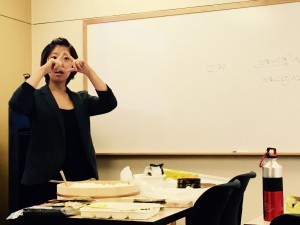
![FullSizeRender[2]](http://sites.coloradocollege.edu/blockfeatures/files/2015/12/FullSizeRender2-300x257.jpg)
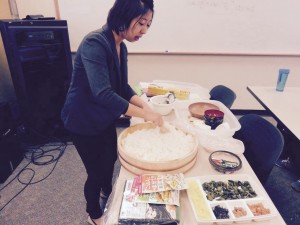
![FullSizeRender[4]](http://sites.coloradocollege.edu/blockfeatures/files/2015/12/FullSizeRender41-225x300.jpg)
![FullSizeRender[2]](http://sites.coloradocollege.edu/blockfeatures/files/2015/12/FullSizeRender21-225x300.jpg)
![FullSizeRender[3]](http://sites.coloradocollege.edu/blockfeatures/files/2015/12/FullSizeRender31-225x300.jpg)
